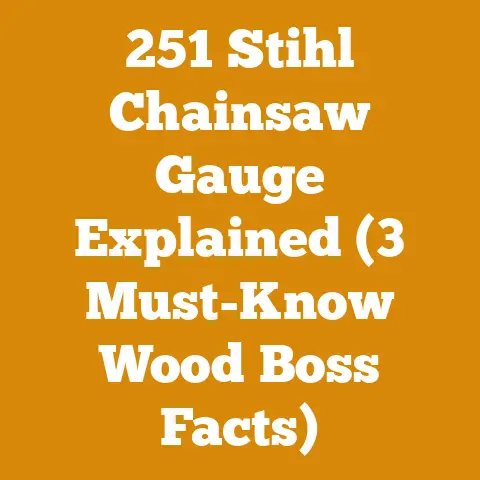Chainsaw Upgrades (5 Pro Tips for Faster Wood Processing)
Introduction: Chainsaw Upgrades (5 Pro Tips for Faster Wood Processing)
When I first started cutting firewood to heat my small cabin, I thought any old chainsaw would do. I quickly learned that a stock chainsaw, while functional, can be a serious bottleneck when you’re trying to process a significant amount of wood efficiently. The good news is, you don’t need to buy a top-of-the-line, professional logging saw to see a real improvement in your wood processing speed. The key is smart, cost-effective upgrades that optimize your saw for the specific tasks you’re tackling.
In this article, I’m going to share five pro tips that I’ve personally used over the years to significantly boost my chainsaw’s performance and make my wood processing faster and less strenuous. These upgrades focus on maximizing the efficiency of your existing saw without breaking the bank. We’ll delve into everything from choosing the right chain and bar to fine-tuning your saw’s carburetor for optimal power. Let’s get started!
1. A dull or poorly chosen chain can drastically reduce your saw’s performance, making wood processing a slow and arduous task.
Understanding Chain Types
There’s a dizzying array of chainsaw chains available, each designed for specific applications. Here’s a breakdown of the most common types:
-
Full Chisel: These chains have square-cornered teeth that offer the fastest cutting speed. However, they are more prone to dulling in dirty or abrasive conditions. I typically reserve these for clean wood and experienced users.
-
Semi-Chisel: These chains have rounded corners on the teeth, making them more durable and forgiving in dirty wood. They offer a good balance between cutting speed and longevity, which I find perfect for general-purpose use.
-
Low-Profile (Micro-Chisel): Designed for smaller saws and less experienced users, these chains have a rounded tooth profile and reduced kickback potential. While they cut slower, they are safer and easier to control.
-
Ripping Chains: These are specifically designed for cutting wood lengthwise, such as milling logs into boards. The teeth are ground at a different angle than cross-cutting chains, resulting in a smoother and more efficient cut along the grain.
Choosing the Right Chain for the Job
The best chain for you depends on the type of wood you’re cutting, the condition of the wood, and your skill level. Here’s my general guide:
-
Clean Hardwoods (Oak, Maple, Ash): Full chisel chains will give you the fastest cutting speed, but be prepared to sharpen them more frequently. I always keep a few sharp full chisel chains handy for when I’m working with freshly felled hardwoods.
-
Dirty or Knotty Wood: Semi-chisel chains are a better choice for dirty or knotty wood, as they are more resistant to dulling. I’ve found these chains to be invaluable when clearing fallen trees after a storm.
-
Softwoods (Pine, Fir, Spruce): Either full or semi-chisel chains will work well on softwoods. I often use semi-chisel chains, as they tend to last longer and require less frequent sharpening.
-
Milling: If you’re milling logs into boards, you’ll need a ripping chain. Don’t even try using a standard cross-cutting chain for milling – you’ll be fighting the wood the entire time.
My Personal Experience with Chains
I once tried to cut through a particularly knotty oak log with a dull, low-profile chain. It took me forever, and the saw kept bogging down. After switching to a sharp, semi-chisel chain, the saw sliced through the log like butter. That experience taught me the importance of using the right chain for the job.
Data Point: Chain Sharpening
Industry statistics show that a sharp chain can increase cutting efficiency by up to 50%. This means you’ll be able to process more wood with less effort and fuel. Investing in a good chain sharpener and learning how to use it properly is one of the best things you can do to improve your chainsaw’s performance.
Actionable Advice
Before you start cutting, inspect your chain for damage or dullness. If the teeth are rounded or chipped, or if the chain is cutting slowly, it’s time to sharpen or replace it. I recommend keeping a spare chain on hand so you can quickly swap it out when needed.
2. Bar None: Optimizing Your Chainsaw Bar
The chainsaw bar is another critical component that can significantly impact your saw’s performance. Choosing the right bar length and type can make wood processing faster, safer, and more efficient.
Bar Length: Finding the Sweet Spot
The general rule of thumb is to use the shortest bar length that can handle the size of wood you’re typically cutting. A longer bar allows you to cut larger diameter logs, but it also adds weight and reduces maneuverability.
-
Small Saws (14-16 inch bar): Ideal for limbing, pruning, and cutting small firewood.
-
Medium Saws (18-20 inch bar): A good all-around choice for felling small trees and processing firewood.
-
Large Saws (20+ inch bar): Necessary for felling large trees and milling logs.
I personally prefer a 18-inch bar on my primary chainsaw. It’s long enough to handle most of the firewood I process, but it’s still relatively lightweight and easy to maneuver.
Bar Types: Laminated vs. Solid
Chainsaw bars come in two main types: laminated and solid.
-
Laminated Bars: These bars are made from multiple layers of steel that are welded together. They are lighter and less expensive than solid bars, making them a good choice for occasional users.
-
Solid Bars: These bars are made from a single piece of steel. They are more durable and resistant to bending than laminated bars, making them a better choice for professional users or those who frequently cut large wood.
Bar Maintenance: Keeping It Straight
Proper bar maintenance is essential for ensuring optimal chainsaw performance and extending the life of your bar. Here are a few tips:
-
Clean the bar regularly: Remove sawdust and debris from the bar groove and oil holes. A clogged bar can lead to overheating and premature wear. I use a small screwdriver or wire to clean the groove and holes after each use.
-
Check the bar for wear: Look for signs of wear, such as burrs, uneven rails, or a bent bar. If you notice any of these problems, it’s time to dress or replace the bar.
-
Dress the bar rails: Use a bar rail dressing tool to remove burrs and even out the rails. This will help the chain run smoothly and prevent premature wear.
-
Flip the bar regularly: Flipping the bar will help to distribute wear evenly and extend its life.
Case Study: Bar Wear and Chain Performance
I once neglected to clean and dress my chainsaw bar for an extended period. As a result, the bar rails became uneven, causing the chain to bind and cut crookedly. This significantly reduced my cutting speed and made the saw more difficult to control. After replacing the bar and implementing a regular maintenance routine, my saw’s performance improved dramatically.
Actionable Advice
Choose the right bar length for the type of wood you’re cutting. Clean and maintain your bar regularly to ensure optimal performance and extend its life. Consider upgrading to a solid bar if you frequently cut large wood or use your chainsaw for professional purposes.
3. Carburetor Calibration: Unleashing Hidden Power
The carburetor is responsible for mixing air and fuel in the correct proportions to create a combustible mixture that powers your chainsaw. Over time, the carburetor can become dirty or misadjusted, leading to reduced power, poor fuel economy, and difficulty starting. Calibrating your carburetor can often unleash hidden power.
Understanding Carburetor Adjustments
Most chainsaws have three adjustment screws on the carburetor:
-
L (Low-Speed): Controls the fuel mixture at idle and low speeds.
-
H (High-Speed): Controls the fuel mixture at high speeds.
-
LA (Idle Speed): Controls the engine’s idle speed.
Adjusting these screws can fine-tune your chainsaw’s performance and optimize it for the specific conditions you’re working in.
The Calibration Process
Warning: Improper carburetor adjustments can damage your chainsaw engine. If you’re not comfortable performing these adjustments yourself, it’s best to take your saw to a qualified mechanic.
Here’s my step-by-step guide to calibrating your chainsaw carburetor:
-
Warm up the engine: Start the chainsaw and let it run for a few minutes to warm up the engine.
-
Adjust the idle speed: Turn the LA screw until the engine idles smoothly without stalling or the chain spinning.
-
Adjust the low-speed mixture: Turn the L screw until the engine accelerates smoothly from idle to full throttle. If the engine hesitates or bogs down, turn the L screw counterclockwise to richen the mixture. If the engine runs roughly or smokes excessively, turn the L screw clockwise to lean the mixture.
-
Adjust the high-speed mixture: This is the most critical adjustment. With the engine running at full throttle, turn the H screw until the engine runs smoothly without sputtering or detonating. If the engine sputters or detonates, turn the H screw counterclockwise to richen the mixture. If the engine runs smoothly but lacks power, turn the H screw clockwise to lean the mixture.
Important: It’s better to err on the side of a slightly rich mixture (turning the H screw counterclockwise), as a lean mixture can damage your engine.
Fine-Tuning for Altitude
Altitude can significantly affect your chainsaw’s performance. As you go higher in altitude, the air becomes thinner, which means there is less oxygen available for combustion. This can cause the engine to run rich, leading to reduced power and poor fuel economy.
To compensate for altitude, you may need to lean out the carburetor mixture by turning both the L and H screws clockwise. The amount of adjustment will depend on the altitude. I typically make small adjustments and test the saw’s performance until I find the optimal setting.
Personal Story: Altitude Adjustment
I once took my chainsaw to a mountain cabin at an elevation of 8,000 feet. The saw ran poorly, sputtering and lacking power. After leaning out the carburetor mixture, the saw ran much better and was able to handle the workload.
Data Point: Fuel Efficiency
A properly calibrated carburetor can improve fuel efficiency by up to 15%. This can save you money on fuel and reduce your environmental impact.
Actionable Advice
Calibrate your chainsaw carburetor regularly to ensure optimal performance and fuel economy. Pay attention to the engine’s performance and make adjustments as needed. If you’re working at high altitude, lean out the carburetor mixture to compensate for the thinner air.
4. Exhaust Modification: Breathing Easier for More Power
The exhaust system plays a critical role in your chainsaw’s performance. A restrictive exhaust system can limit the engine’s ability to breathe, reducing power and efficiency. Modifying the exhaust system can improve airflow and unlock additional horsepower.
Understanding Exhaust Restrictions
The stock exhaust systems on many chainsaws are designed to meet emissions regulations and noise standards. These systems often incorporate features that restrict airflow, such as catalytic converters and small exhaust ports.
The Muffler Mod
One of the most common exhaust modifications is the “muffler mod.” This involves drilling additional holes in the muffler to increase airflow.
Warning: Modifying your chainsaw’s exhaust system may void your warranty and could potentially increase noise levels. Check your local regulations before performing any modifications.
Here’s how I typically perform a muffler mod:
-
Remove the muffler: Carefully remove the muffler from the chainsaw.
-
Drill additional holes: Drill several additional holes in the muffler, focusing on areas that are not directly in the path of the exhaust flow. I typically use a drill bit that is slightly smaller than the existing exhaust port.
-
Clean up the edges: Use a file or grinder to smooth out the edges of the new holes.
-
Reinstall the muffler: Reinstall the muffler on the chainsaw.
Benefits of Exhaust Modification
-
Increased Power: By improving airflow, exhaust modification can increase your chainsaw’s power output, especially at higher RPMs.
-
Improved Throttle Response: A less restrictive exhaust system can improve throttle response, making the saw feel more responsive and easier to control.
-
Reduced Engine Temperature: Improved airflow can help to reduce engine temperature, which can extend the life of your engine.
Risks of Exhaust Modification
-
Increased Noise: Exhaust modification can increase the noise level of your chainsaw.
-
Potential Warranty Issues: Modifying your chainsaw’s exhaust system may void your warranty.
-
Risk of Engine Damage: If not done correctly, exhaust modification can damage your engine.
Data Point: Power Increase
Some studies have shown that exhaust modification can increase a chainsaw’s power output by up to 10%. While this may not seem like a lot, it can make a noticeable difference when cutting large wood.
Actionable Advice
Consider modifying your chainsaw’s exhaust system if you’re looking to increase power and improve throttle response. Be aware of the potential risks and take precautions to avoid damaging your engine. Check your local regulations before performing any modifications.
5. Clutch Optimization: Transferring Power Efficiently
The clutch is the mechanism that transfers power from the engine to the chain. A worn or poorly adjusted clutch can slip, reducing cutting efficiency and potentially damaging the engine. Optimizing your clutch can improve power transfer and extend its life.
Understanding Clutch Mechanics
A chainsaw clutch typically consists of a centrifugal clutch drum, clutch shoes, and springs. As the engine speed increases, the centrifugal force causes the clutch shoes to engage with the clutch drum, transferring power to the chain.
Clutch Problems and Solutions
-
Clutch Slippage: This is the most common clutch problem. It occurs when the clutch shoes are worn or the springs are weak, causing the clutch to slip and reducing cutting efficiency. The solution is to replace the clutch shoes and/or springs.
-
Clutch Drum Wear: The clutch drum can also wear over time, leading to slippage. If the clutch drum is worn, it should be replaced.
-
Clutch Binding: This occurs when the clutch shoes are sticking or the clutch drum is corroded, preventing the clutch from engaging properly. The solution is to clean and lubricate the clutch components.
Clutch Upgrades
-
Heavy-Duty Clutch Springs: Upgrading to heavy-duty clutch springs can increase the clutch engagement speed and improve power transfer, especially when cutting large wood.
-
Aftermarket Clutch Kits: Some aftermarket clutch kits offer improved clutch shoe materials and designs for increased durability and performance.
My Clutch Replacement Experience
I once had a chainsaw that was constantly slipping, making it difficult to cut through even small logs. After inspecting the clutch, I found that the clutch shoes were worn down to the metal. Replacing the clutch shoes and springs completely resolved the problem and restored the saw’s cutting power.
Data Point: Clutch Lifespan
The lifespan of a chainsaw clutch depends on usage and maintenance. However, most clutches will last for several years with proper care. Regularly inspecting and maintaining your clutch can help to extend its life.
Actionable Advice
Inspect your chainsaw clutch regularly for signs of wear or damage. Replace worn clutch shoes and springs as needed. Consider upgrading to heavy-duty clutch springs for improved power transfer.
Conclusion: Putting It All Together
Upgrading your chainsaw doesn’t have to involve expensive modifications or replacing the entire saw. By focusing on these five key areas – chain, bar, carburetor, exhaust, and clutch – you can significantly improve your saw’s performance and make wood processing faster, easier, and more efficient. Remember to always prioritize safety and follow the manufacturer’s instructions when performing any modifications or repairs. Now get out there and cut some wood!






